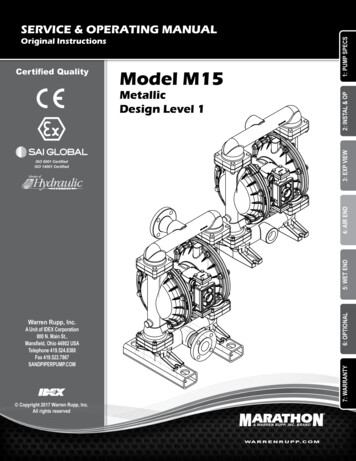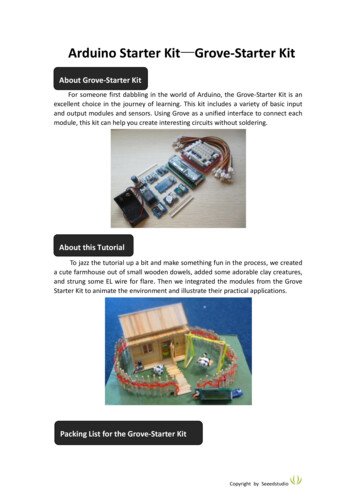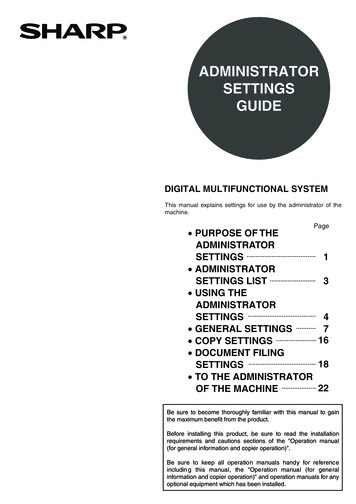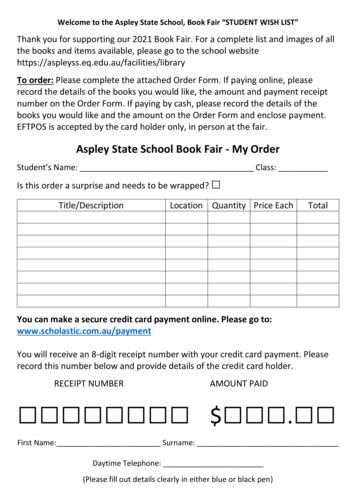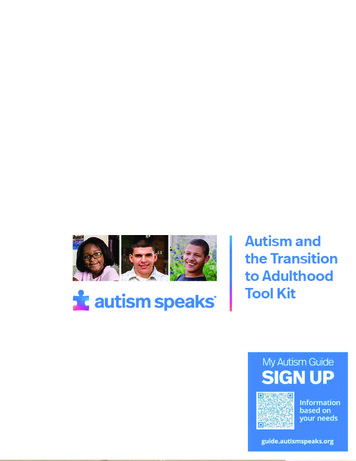
Transcription
TransitioningTransitionToolToolKit KitForFamilies onthe Journey from Adolescence to AdulthoodA SubheadHere?FAMILY SERVICES
TRANSITION TOOL KITThe Transition Tool Kit is designed to assist families of individualswith autism on the journey from adolescence to adulthood.Autism Speaks does not provide medical or legal advice or services. Rather,Rather, Autism Speaks providesgeneral information about autism as a service to the community.community. The information provided in this tool kitis not a recommendation, referral or endorsement of any resource, therapeutic method, or serviceprovider and does not replace the advice of medical, legal or educational professionals. Autism Speakshas not validated and is not responsible for any information or services provided by third parties. You areurged to use independent judgment and request references when considering any resourceassociated with the provision of services related to autism. 2018 Autism Speaks Inc. Autism Speaks and Autism Speaks Design are registered trademarks owned by Autism Speaks Inc. All rights reserved. The use of unaffiliatedrepresentatives for endorsement, advertising, promotional and sales material is prohibited by law.
TRANSITION TOOL KITACKNOWLEDGEMENTSAutism Speaks would like to extend special thanksto the Parent Advisory Committee for the time andeffort that they put into reviewing the TransitionTool Kit.PARENT ADVISORY COMMITTEEDan AronsonLiz BellSallie BernardMichele Pierce BurnsLiane CarterMarc CarterClaire DeesSusan Logan EvensenKathy MannionDenise ResnikLaura ShumakerFrank TurnerJennifer ZarrilliPROFESSIONAL ADVISORY COMMITTEEDan Baker, Ph.D.Director, Community Positive Behavior Support,Transition and Supported Employment ProjectsAssociate Professor of PediatricsBoggs Center on Developmental DisabilitiesRobert Wood Johnson Medical School, UMDNJJan Blacher, Ph.D.Founding Director, SEARCH Family AutismResource CenterDistinguished Professor of Education,UC Presidential ChairGraduate School of Education,University of California, RiversideSusan L. Connors, M.D.Instructor, Harvard Medical SchoolAssistant Physician, MassGeneral Hospital for ChildrenLurie Family Autism Center/LADDERSJanet Farmer, Ph.D., ABPPProfessor and Director of Academic ProgramsThompson Center for Autism & NeurodevelopmentalDisordersUniversity of MissouriPeter Gerhardt, Ed.D.Founding Chair of the Scientific Council,Organization for Autism ResearchJeri KendleSocial Enterprise Strategist, Former PresidentSouthwest Autism Research and Resource Center(SARRC)Robin Martin Marsh, Ph.D./NCSPSenior Continuing Education CoordinatorThompson Center for Autism & NeurodevelopmentalDisordersUniversity of Missouri-ColumbiaCaroline I. Magyar, Ph.D.Associate Professor of PediatricsUniversity of Rochester Medical CenterShana Nichols, Ph.D.Owner/Director,ASPIRE Center for Learning and DevelopmentDiane Osaki, OTRValerie Paradiz, Ph.D.Director, Valerie Paradiz LLCDirector, Autistic Global InitiativeParent and self-advocateMary Ann Powers, Ph.D., BCBA-DSenior Behavior AnalystCoryell Autism CenterStephen Shore, Ed.D.Assistant Professor of EducationAdelphi UniversityPaul Wehman, Ph.D.Chairman, Division of Research, Department of PhysicalMedicine and RehabilitationDirector, Autism Center for ExcellenceDirector, Rehabilitation Research and training CenterVirginia Commonwealth UniversityNicole Weidenbaum, M.S.Ed., SASExecutive DirectorNassau Suffolk Services for Autism (NSSA)
TRANSITION TOOL KITFAMILY SERVICES COMMITTEELiz BellParentPaul Shattuck, M.S., M.S.S.W., Ph.D.Leader, AJ Drexel Autism Institute Research ProgramArea on Life Course OutcomesSallie Bernard*ParentExecutive Director, SafeMindsStephen Shore, Ed.D.Assistant Professor, Special Education,Adelphi UniversityCuong Do*ParentMichelle SmigelParentPeter Faustino, Psy.D.NY Delegate, National Association of SchoolPsychologistsLicensed Psychologist, Developmental Assessment& Intervention CenterPeter Gerhardt, Ed.D.Founding Chair of the Scientific Council,Organization for Autism ResearchMel Karmazin*GrandparentBrian Kelly **Parent*Autism Speaks Board Member**Chairperson – Autism Speaks Board of DirectorsParent – Indicates Parent of a Child with AutismWe wish to express our appreciation and gratitudeto all of the adolescents and young adults withautism spectrum disorders and their families fortheir perseverance and inspiration.Autism Speaks thanks the American Legion ChildWelfare Foundation for their generous contributionto help fund Version 2.0 of the Autism SpeaksTransition Tool Kit.Artie Kempner*ParentGary S. Mayerson*Founding Attorney, Mayerson & AssociatesKevin Murray*ParentLinda S. Meyer, EdD, MPA, BCBA-D, CPTAutism ConsultantDanny Openden, Ph.D., BCBA-DPresident and CEO, Southwest Autism Researchand Resource Center (SARRC)Valerie Paradiz, Ph.D.Director, Valerie Paradiz LLCDirector, Autistic Global InitiativeParent and Self-advocateLori RicklesParentStuart SavitzParentAutism Speaks also thanks the following supporterswho helped fund Version 1.0 in 2011:- Bank of America- NYSE Euronext Foundation- MassMutual Financial Group- The Karma Foundation- Susan Logan Evensen and Peter Evensen- Jenny and Joe Zarrilli
TRANSITION TOOL KITTable of ContentsIntroduction1Self-Advocacy 3What is Self-Advocacy? 3How Do We Teach Self-Advocacy Skills?Person-Centered Planning45Developing Independent Living Skills 7Ten Ways to Build Independence7Teaching Daily Living Skills 9Planning for Transition 11Transition Planning and the IEP11Getting Started: Preparing for the Transition IEP Meeting12The Transition Meeting 14Steps for Creating a Transition Plan14Diploma Options 15Evidence-Based Predictors for Post-School Success16Legal Matters to Consider 17Health Insurance 17Guardianship 18Special Needs Trusts 20Support Programs 21Community Living 25Picking the Right Activities 25Travel Training 27Safety 28Preventing Abuse 29Employment and Other Options 31Preparation 31Types of Employment 32Job Matching and Searching 32Workplace Skills 34Other Options 35Additional Resources 36
TRANSITION TOOL KITPostsecondary Educational Opportunities 37Types of Postsecondary Education 37504 Plans 38Differences Between High School and College39Choosing the Right School 40Self-Advocacy in Postsecondary Education 41Housing and Residential Supports 43Where Do I Begin? 43Models for Residential Support 44Funding Options 45Health 48Finding the Right Doctor 48Mental Health 48Personal Hygiene 49Puberty and Sexuality 49Technology 51How Technology Can Help 51Social Media and Internet Safety 52The Importance of Digital Literacy 54Assessments 54Conclusion 55Resources 56
TRANSITION TOOL KITIntroductionThe guiding principle that we used indeveloping this kit is that all individuals withautism, regardless of the level of supportneeded, should be able to live a life filled withpurpose, dignity, choices and happiness.The future can often seem uncertain for a youngadult with autism. It may be hard for you to imagineyour child out in the world, or what he or she willdo once the school bus is no longer arriving eachmorning. Some parents find the thought of thetransition process overwhelming. Many families havespent years researching, negotiating and advocatingfor services and supports to maximize their child’spotential during his or her school years. And thethought of doing this again with a whole new systemcan seem daunting.To ease your fears and help you startdeveloping your child’s transition plan,you have come to the right place!As overwhelmed as you might be, try to be positivewhen thinking about the future. Take a look backand think about all of the strides that your child hasmade so far, and how much you have learned alongthe way. One lesson you may have learned over andover is the importance of being proactive.Keep in mind, too, that many others have traveledthis road before you, and lots of information andresources have been developed to help you alongthe way. Additionally, experts in the field haveresearched and investigated the process and wehave compiled a great deal of this information andmany of these resources into this guide. The bestnews is that autism awareness is continuing togenerate more opportunities for growth in the transition process, which can lead to more opportunitiesfor young adults with autism like your child!As parents and caregivers, we all want our children(those living with or without autism) to be happy andto live fulfilling lives. It is important to remember thatwhat constitutes happiness or fulfillment for a personis specific to that individual. All young adults livingwith autism have their own unique strengths andchallenges, as well as their own specific likes anddislikes. So what may be an appropriate or desiredemployment, housing, postsecondary education orcommunity involvement option for one individual maynot be the right fit for someone else.This kit will provide you with suggestions andoptions for you to consider as you set out on thisjourney toward finding your child’s own uniquepath to adulthood.1
TRANSITION TOOL KITWith the importance of finding your child’s ownspecific path in mind, the development of selfadvocacy and independent living skills is highlightedthroughout this kit. We have broken the kit downinto different sections. At the end of the kit, we haveprovided resources specific to each section. Sincethe transition process is different in each state, wehave also developed timelines for each state, withstate agency information that may be helpful to youthroughout this process.When it comes to transition planning, it can be helpfulto start thinking about the future as early as possible.Some parents even start the transition conversationwith their child’s school by age 12 or 13. And whileit is never too early to think about the future of yourchild, if your child is older and close to finishing highschool or aging out of the school system, restassured that it is also never too late!It can also help to work backwards. Think aboutwhere you see your child in the future based on his orher strengths, challenges, abilities and preferences.What type of job will he or she have? Where will heor she live? The transition plan should be developedand then adjusted through the years with these ultimate goals in mind. Where do you see your child inten years? To get there, where do you see him or herin five years? Two years? Six months? Working backwards can help you stay on track and take the necessary steps now to get to the future you and your childdream of.Remember that all roads do not lead to the sameplace. The path will be different for each family, butthe goal remains the same: that your young adult withautism will lead a fulfilling and happy adult life. Withsome planning and collaborative efforts with yourchild, family members, educators and other professionals involved in his or her life, you will succeedin accomplishing this goal!Happy reading!2
TRANSITION TOOL KITSelf-AdvocacyThe most important place to start the transition process is with your child who is now or will soon be anadolescent or young adult. His or her hopes, dreamsand desires should drive the process.Self-advocacy plays a vital role innearly every aspect of life The more self-aware people on the spectrumbecome, the more they can be players inadvocating for their own comfort, happinessand well-being.Some individuals with autism can verbally communicate their goals and ideas for their adult lives. Theseconversations should serve as starting points todevelop their transition plans.- Valerie Paradiz, Ph.D.,The Integrated Self-Advocacy CurriculumSome adolescents may not be developmentallyready to tackle the transition process. Others maybe unable to express their wants and needs for thecoming years due to limited communication skills.This is particularly challenging for families, as manywant to provide their adolescent with the life that heor she wants.Self-advocacy involves speaking up for yourself,asking for what you need, negotiating for yourself,knowing your rights and responsibilities and usingthe resources that are available to you. It is never tooearly to begin to teach self-advocacy skills. Learningto ask for help is another step in developing selfadvocacy skills. In order to do this, the individualmust be able to identify that there is an obstacle ordifficulty, and then seek out assistance to have theissue resolved.Remember that transition planningis not a single conversation, but rathera process that will evolve over time.The transition process will take time. It is importantthat you work with your adolescent to provide thecommunication, self-help and self-advocacy skillsthat he or she needs in order to be an active participant in the process.DisclosureIt is important to note that part of self-advocacy mayinvolve disclosure. Therefore, it is important that anadolescent be told that he or she has autism. Be sureto share with your child or adolescent that autismhas provided him or her with strengths, as well ascertain challenges. Each person will react differently,but many individuals with autism have shared thatthey were relieved to know that there is a label forwhat may make things more difficult. These individuals realized that their challenges are not due to anyfault of their own, but only because their brains workdifferently. It may be helpful for the individual to joina support or social skills group for those with similarabilities. You may be able to find groups in your areain the Autism Speaks Resource Guide atAutismSpeaks.org/resource-guide.What is Self-Advocacy?For most of your child’s life, you have probably beendoing the advocating – making decisions for him orher and making sure your child has gotten what heor she needs, wants and deserves. However, asindividuals with autism age, they will need to learn toadvocate for themselves to the best of their ability.Helping adolescents with autism to develop a senseof self will aid in the transition process and will develop a skill that will benefit them throughout their lives.3
TRANSITION TOOL KITMatthew is a 15-year-old boy withautism and limited verbal skills.Matthew and his family frequently go tothe local ice cream shop. Matthew’s dadworked with him to teach him to order hisown ice cream. Matthew was fairly competent at doing this, and so his dad suggestedthat he go into the shop by himself andorder. Matthew’s dad would watch throughthe store front window. Matthew went inwith his money and ordered his ice cream.When Matthew came out of the store, hewas unhappy because he didn’t get themint chocolate chip ice cream that hehad asked for. Matthew’s dad guided himthrough his options. They identified threeoptions: Matthew could get very upsetbecause he didn’t get the ice cream flavorthat he wanted and have no ice cream;he could eat the ice cream that he got; orhe could go back into the store and let theserver know that he had asked for mintchocolate chip. Matthew decided to goback into the store. Before Matthew wentin, his dad helped him practice what heneeded to say. Matthew was very nervous,but he went back into the shop. He showedthe server the ice cream he got and he toldhim that he wanted mint chocolate chip.The server apologized for the error andgave Matthew the mint chocolate chip thathe had wanted. Matthew was so happy tohave his mint chocolate chip ice cream,and his dad was very pleased withMatthew’s new found self-advocacy skills.How Do We TeachSelf-Advocacy Skills?Self-advocacy should be taught throughout aperson’s lifetime. It can start in small ways by teaching an individual to make choices. Gradually, moreadvanced skills such as those involving negotiationsand disclosure should be added to the curriculum ifappropriate. Teaching self-advocacy skills will be aprocess and it will take time to acquire these skills.It is important to teach your child or adolescent aboutthe decision-making process, i.e. clearly defining thedecision, weighing pros and cons and learning fromeach choice for next time. Start with decisions assimple as what clothes to wear each day. You caneventually build up to decisions about making his orher own schedule, all the way up to decisions likewhat therapists to work with and what topics shouldbe discussed at an IEP meeting.There are several tools that are available to help youand your child think about what he or she wants andbuild the skills necessary to communicate his or herdesires for the future. See the Resource section ofthis tool kit for more information.4
TRANSITION TOOL KITPerson-Centered PlanningPATH: Planning Alternative Tomorrowswith HopeAs mentioned, the development of the transition planshould be driven by your child’s desires, preferences,strengths and challenges. This is the theory behindperson-centered planning.PATH is a person-centered planning and goal-settingtool used to map out a vision of a desirable future forthe individual. This tool helps families to think aboutthe future and then work backwards to determine thesteps necessary to achieve that future.The process usually starts with an initial team meeting to identify opportunities for the focus person toparticipate in the community, find employment orpostsecondary education and live as independentlyas possible. To the best of his or her ability, your childshould play a central role in the meeting. He or sheshould even choose who to invite to this meeting –this might be family members, friends, teachers,therapists, etc. The process will provide you and youradolescent with a vision for his or her future andsome specific steps to get there. Team members areresponsible for implementing the strategies discussed in planning meetings. It is best to prepareyour child as much as possible for these meetingsso he or she is able to participate as much aspossible.PATH, developed by Jack Pearpoint, John O’Brienand Marsha Forest, starts with identifying the individual’s “dream” and creating a portrait for the futurehe or she desires. Based on this ultimate vision, theteam then thinks about the goals for 1-2 years ahead,followed by the next few months and continuing tothe present. The team next determines the immediatesteps that should be taken to achieve that long-termvision.PATH resources can be found atinclusion.com/path.html.MAPS: Making Action PlansMore information about person-centered planningcan be found on the PACER Center website and individuals and families can get assistance with personcentered planning by contacting their local UniversityCenter on Excellence in Developmental Disabilitiesor Parent Training and Information Center.MAPS is a collaborative action planning processused to help an individual create a plan for his or herown life. During the meeting, the team develops aMAP to serve as the compass that points in thedirection of a positive future for the individual withautism. Some essential elements of a MAP meeting include a personal and informal atmosphere, thepresence and participation of the focus person andthe key actors in his or her life, the discussion of keyissues and the development of a concrete plan ofaction to begin right away.There are several person-centered planning toolsavailable to families. Below is information abouttwo tools that families have found helpful.There are eight questions that should be coveredby the facilitator in the MAPS meeting, dividedinto 2 parts:PART I1) What is a MAP?2) What is the person’s story?3) What is your dream?4) What is your nightmare?5
TRANSITION TOOL KITThis is an example of map planning.ConclusionSo when thinking about all aspects of transitionplanning, keep in mind that teaching your child toadvocate for him or herself can make a big differencein helping him or her to secure the supports andservices needed to live the life that he or she wantsand deserves. It may seem overwhelming to you tothink about teaching these important skills, butremember that you can start very small and buildupon these skills gradually and to the best of yourchild’s ability. Even just teaching your child that heor she has the right to make or contribute to decisions big and small can go a long way. You may notthink your child has the ability to make decisions forhim or herself, but remember that even though itmay not be easy to communicate them, your childhas thoughts and feelings just like any other youngadult who wants to shape his or her own future.PART II5) Who is the person?6) What are the person’s talents, giftsand strengths?7) What are the person’s likes and needs?8) What is the plan of action?The answers to these questions should drive thedevelopment of a MAP for the individual. Above isan example of the MAP of an adolescent withautism: MAPS information and resources can befound at inclusion.com/maps.html.Start small, start early and you cansucceed in providing your child witha life of happiness and dignity.6
TRANSITION TOOL KITDevelopingIndependent LivingSkillsIn addition to self-advocacy skills, teaching your childskills that will foster his or her independence on thejourney to adulthood is also of utmost importance.As autism is a spectrum disorder, every individualis different, and as a result, the independent livingskills that will be taught, as well as the pace at whichthey are taught, will vary significantly across thespectrum. For example, one young adult with autismmay ultimately be able to live on his or her own withvery little, if any, outside support, while another mayrequire supports and services 24 hours a day, 7 daysa week.block, you can help your loved one with autism gainthe tools that will allow him or her to be more independent throughout his or her life.As with self-advocacy, starting to develop independence skills to the best of your child’s ability at ayoung age will make a difference in terms of the easeof this transition period. Building these skills little bylittle is an effective way to teach skills you may nothave thought your child would need one day.1. Strengthen CommunicationIf your child struggles with spoken language, acritical step for increasing independence is strengthening his or her ability to communicate by buildingskills and providing tools to help express preferences,desires and feelings. Consider introducingAlternative/Augmentative Communication (AAC)and visual supports. Common types of AAC includepicture exchange communication systems (PECS),speech output devices (such as DynaVox, iPad, etc.)and sign language.Teaching your child independent living skills - homeliving, personal care, etc. - can be easier said thandone, especially if he or she is accustomed to havingthings done for him or her. You may be rushed, yourchild may be fighting you every step of the way, youmay be too exhausted, but teaching life skills early onis an important part of raising a child with autism.2. Introduce a Visual ScheduleUsing a visual schedule with your child can help thetransition from activity to activity with less prompting.Review each item on the schedule with your childand then remind him or her to check the schedulebefore every transition. Over time, he or she will beable to complete this task with increasing independence, practice decision making and pursue theactivities that interest him or her. You can learn moreabout using visual supports by downloading theATN/AIR-P Visual Supports and Autism SpectrumDisorder Tool Kit.Ten Ways to BuildIndependenceThis list from Autism Speaks Autism Response Teammember Emily Mulligan provides information on howyou can help your child increase his or her independence at home, at school and in the community. Byintroducing these skills early and building block by7
TRANSITION TOOL KIT3. Work on Self-Care Skills7. Teach Community Safety SkillsThis is a good age to introduce self-care activitiesinto your child’s routine. Brushing teeth, combinghair and other activities of daily living (ADLs) areimportant life skills, and introducing them as early aspossible can allow your child to master them downthe line. Make sure to include these things on yourchild’s schedule so he or she gets used to havingthem as part of the daily routine.Safety is a big concern for many families, especiallyas children become more independent. Teach andpractice travel training including pedestrian safety,identifying signs and other important safety markers;and becoming familiar with public transportation.The GET Going pocket guide has many useful tipsto help individuals with autism navigate public transportation. Consider having your child carry an ID cardwhich can be very helpful to provide his or her name,a brief explanation of his or her diagnosis, and acontact person. You can find examples of ID cardsand other great safety materials.4. Teach Your Child to Ask for a BreakMake sure your child has a way to request a break– add a “Break” button on his or her communication device, a picture in his or her PECS book, etc.Identify an area that is quiet where your child can gowhen feeling overwhelmed. Alternatively, consideroffering headphones or other tools to help regulatesensory input. Although it may seem like a simplething, knowing how to ask for a break can allow yourchild to regain control over him or herself and his orher environment.8. Build Leisure SkillsBeing able to engage in independent leisure andrecreation is something that will serve your childwell throughout his or her life. Many people withautism have special interests in one or two subjects;it can help to translate those interests into ageappropriate recreational activities. The AutismSpeaks Resource Guide contains activities thatyour child can get involved with in your community;including team sports, swim lessons, martial arts,music groups and more. For more information aboutparticipation in youth and community organizations,see the Autism Speaks Leading the Way:Autism-Friendly Youth Organizations guide.5. Work on Household ChoresHaving children complete household chores canteach them responsibility, get them involved in familyroutines and impart useful skills to take with them asthey get older. If you think your child may have trouble understanding how to complete a whole chore,you can consider using a task analysis. This is amethod that involves breaking down large tasks intosmaller steps. Be sure to model the steps yourself orprovide prompts if your child has trouble at first! Also,try using My Job Chart: a great tool to help both kidsand adults learn to complete tasks and manage time.9. Teach Self-Care during AdolescenceEntering adolescence and beginning puberty canbring many changes for a teen with autism, so thisis an important time to introduce many hygiene andself-care skills. Getting your teens into the habit ofself-care will set them up for success and allow themto become much more independent as they approachadulthood. Visual aids can be really useful to helpyour teen complete his or her personal hygieneroutine each day. Consider making a checklist ofactivities to help your child keep track of what to doand post it in the bathroom. This can include itemssuch as showering, washing face, putting ondeodorant and brushing hair. To stay organized, youcan put together a hygiene “kit” to keep everythingyour teen needs in one place.6. Practice Money SkillsLearning how to use money is a very important skillthat can help your child become independent whenout and about in the community. No matter whatabilities your child currently has, there are ways thathe or she can begin to learn money skills. At school,consider adding money skills to your child’s IEP andwhen you are with your child in a store or supermarket, allow him and her to hand over the money to thecashier. Step by step, you can teach each part of thisprocess. Your child can then begin using these skillsin different settings in the community.8
TRANSITION TOOL KIT10. Work on Vocational SkillsStarting at age 14, your child should have somevocational skills included on his or her IEP. Make alist of his or her strengths, skills and interests and usethem to guide the type of vocational activities thatare included as objectives. This is also a time to startplanning for the future. Consider all of the ways upto this point that you have been fostering your child’sindependence: communication abilities, self-care,interests and activities and goals for the future. TheCommunity-based Skills Assessment (CSA) canhelp you evaluate your child’s current skills and abilities to create an individualized transition plan.Teaching Daily Living Skills1. Identify when a shower is necessary.2. Turn on the shower.A 2015 study funded by Autism Speaks andFoundation of Hope, presented at the InternationalMeeting for Autism Research (IMFAR), found thatthe single most important predictor of positive outcomes in adulthood is the mastery of self-care skillssuch as bathing, dressing, cleaning and cooking.According to the researchers who tracked childrenwith autism into middle adulthood, these skills provemore important than language, intellectual abilityor the severity of autism symptoms when it comesto maintaining employment and achieving lifesatisfaction.3. Find the desired water temperature.4. Use soap to wash arms, legs andstomach.5. Use soap to wash underarms and privateparts thoroughly.6. Wet and use shampoo to wash hair.7. Rinse off soap and shampoo until nomore bubbles.8. Turn off the shower.9. Dry off with towel.10. Get dressed.We can’t necessarily change IQ orsymptom severity, but we can teach dailyliving skills.Be sure to reinforce your child with positive feedbackonce he or she masters each step. Motivation iscritical to learning and as your child becomes familiarand more competent with new skills, confidence,interest and motivation wil
advocacy and independent living skills is highlighted throughout this kit. We have broken the kit down into different sections. At the end of the kit, we have provided resources specific to each section. Since the transition process is different in each sta



